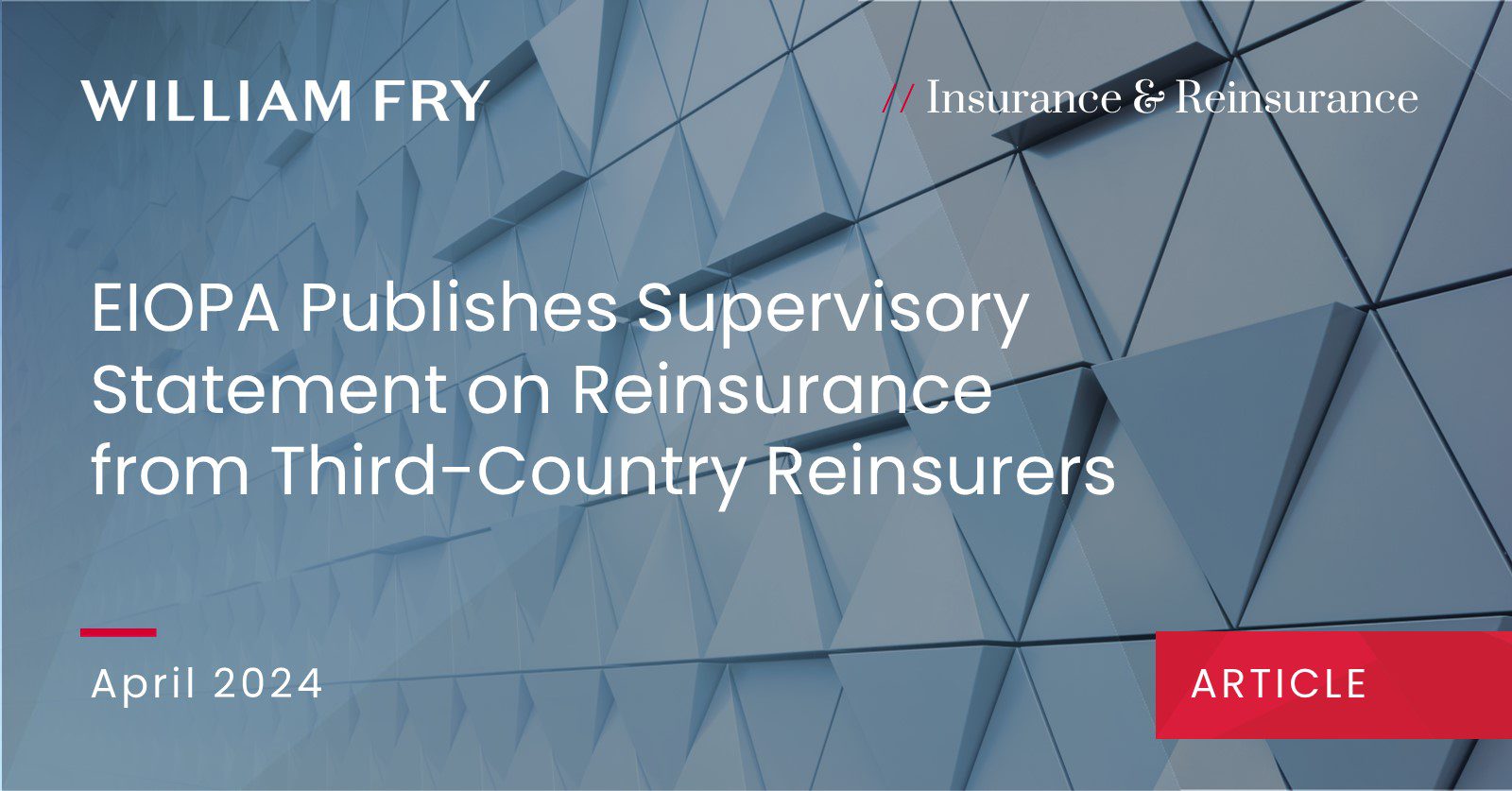On 4 April 2024, EIOPA published its finalised supervisory statement on the supervision of reinsurance concluded with third-country (re)insurance undertakings (Supervisory Statement).
The Supervisory Statement, accompanied by a useful feedback statement, was the outcome of a consultation process carried out by EIOPA during Q3 2023. Unsurprisingly, although some stakeholder feedback was taken on board by EIOPA, the substance of the Supervisory Statement remains largely unchanged from the consultation version.
The objective of the Supervisory Statement is to raise awareness of the risks stemming from sourcing reinsurance from non-equivalent jurisdictions and to propose a risk-based approach to limit the effect of these risks. While primarily addressed to national competent authorities (NCAs) (e.g. the Central Bank of Ireland), it is clear from the feedback statement from the consultation that certain elements present expectations for (re)insurers to consider. The Supervisory Statement states that it does not introduce new legal requirements, but rather aims to clarify and harmonise the existing ones under the Solvency II framework and other EU rules.
The main concerns raised by stakeholders during the consultation process related to how the draft statement would potentially discourage the use of reinsurance capacity in third countries, particularly in how it interacted with the European Commission’s equivalence decisions and bilateral agreements such as the EU-US Covered Agreement. The Supervisory Statement attempts to eliminate this concern by expressly acknowledging the global nature of the reinsurance business and the advantages that this offers. EIOPA recognises that reinsurance is a crucial means for capital and risk management, offering risk diversification, support for additional underwriting capacity, addressing protection gaps and facilitating increased financial stability. In particular, NCAs are reminded of the importance of keeping this context in mind when conducting their supervisory tasks and the importance of “due respect” to the rights and obligations contained in each equivalence decision and any bilateral agreement between the EU and a third country.
The Supervisory Statement does recognise a distinction between insurers and reinsurers and states that EIOPA’s primary concern is with direct insurers reinsuring to third-country counterparties, but it does not exempt retrocession from (a proportionate) application of the Supervisory Statement.
Some elements of the Supervisory Statement, where relevant and explicitly stated, apply also to reinsurance arrangements with reinsurers from third-countries that have been granted equivalence under Solvency II rules.
Key Takeaways
In the Supervisory Statement, EIOPA’s main expectations are categorised in terms of the three main areas on which firms and their respective boards of directors must conduct assessments:
- The business rationale for using third-country reinsurance and early supervisory dialogue – Firms are expected to effectively manage their reinsurance strategy. This includes a consideration of the trade-off between reinsurance premiums and additional risks, the impact on Solvency Capital Requirement and other considerations stemming from the use of third-country reinsurance (equivalent and non-equivalent). The Supervisory Statement “encourages” ongoing supervisory dialogue in respect of third-country reinsurance and proposes that this should occur before firms conclude such arrangements where material risk is being transferred, although it stops short of suggesting that this should be an approval process.
- The insurer’s risk management system regarding the use of third-country reinsurers – Firms should consider whether they can effectively monitor and manage risks created by the domiciles of third-country reinsurers, including any legal and compliance risk, collateral risk and risks of default by the third-country reinsurer. Firms should ensure their policies include principles of reinsurer selection.
- The reinsurance agreement itself – Firms should consider matters including the parties’ termination rights, any side letter agreements that could threaten the effectiveness of the agreement, claims hierarchy in the case of default and any collateral agreements available in the event of default.
Where the assessment of these matters identifies increased material risks, the Supervisory Statement also sets out several risk mitigation tools which they expect undertakings to employ. These include:
- Pre-emptive limitation of exposure to certain third-country reinsurers through careful diversification.
- Mitigation of counterparty default risks using collateral agreements, pledge assets, premium and reserve deposits in cash or securities.
- Ensuring that the firm has a direct claim against that reinsurer in the case of default.
- Inclusion of clauses for regular commutations or threshold-initiated execution of a commutation agreement in reinsurance agreements.
Next Steps
The Supervisory Statement represents a step up in terms of increased supervisory awareness and scrutiny that will be applied to third-country reinsurance arrangements of EU-27 firms. In practical terms, EIOPA’s expectations are likely to also indirectly impact third-country firms who will need to assist EU firms in meeting these expectations.
Ultimately, the Supervisory Statement will cause EU (re)insurers who enter into third-country reinsurance arrangements to review and adapt their reinsurance strategy, risk management systems and reinsurance agreements to ensure they are aligned with EIOPA’s expectations and any additional NCA requirements. It is noteworthy in this regard that the Supervisory Statement does not make any explicit distinction between existing reinsurance arrangements and future transactions after its date of publication. EU (re)insurers may need to enhance their due diligence, monitoring, and reporting in respect of third-country reinsurance arrangements (considering not just the details of the counterparty and the proposed reinsurance contract but explicitly analysing the specific legal and regulatory context within which the counterparty operates, where that is not an equivalent jurisdiction). As described in our previous article here, the Central Bank of Ireland noted in its Insurance Newsletter last July that it may provide additional commentary in this area if it thinks it is needed; it remains to be seen whether further guidance will be forthcoming following the publication of the Supervisory Statement.
To view the Supervisory Statement in full, please click here. To read the accompanying feedback statement, please click here.
If you have any questions on how best to address the implications of EIOPA’s Supervisory Statement, please contact any member of the Insurance & Reinsurance team or your usual William Fry contact.
Contributed by Mike Frazer & Caitlin Lenihan




